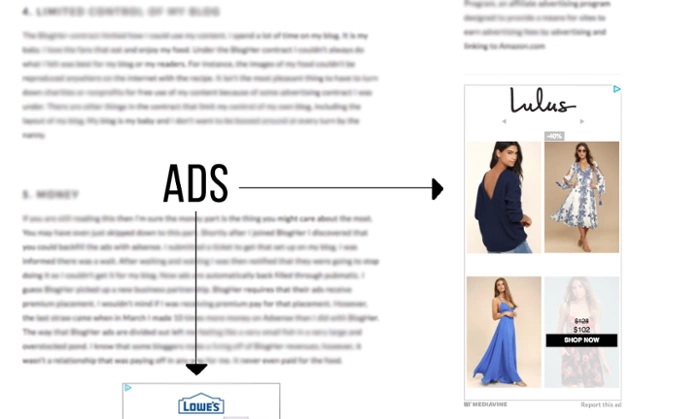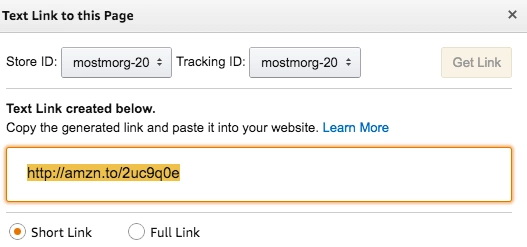Today, there are countless methods you can use to monetize a blog. The trick to learning how to monetize a blog is in choosing the right option for you and your online business.
Some bloggers see thousands of visitors per month on their sites, and yet, blog monetization eludes them.
You may be surprised to know that quite a few Teachable employees have online side hustles. Some of us are bloggers or course creators, while others fall somewhere else entirely.
You can make money as a blogger in a number of ways, and they are not all created equal. In this post, we will explore how to get traffic to your site and the best ways to monetize your blog.
Tips for getting blog traffic
To make money as a blogger, you need to first build an audience. After all, content alone doesn’t make money, the influence that you have on others does. The more people follow and engage with your blog, the more potential you have to make money.
To gain that influence you should be promoting your blog posts and strategically growing your website traffic. There are a couple of ways that you can do this, but the most important is to make it easy for people to find your blog through SEO.
How to get blog traffic with SEO
SEO, or search engine optimization, is a strategy that businesses use to increase their site’s visibility. Mainly, it focuses on increasing your search engine position or ranking in Google for target keywords—the words and phrases that your target audience is searching for.
For example, if you run a “van life” blog, your target audience might search for things related to vans and travel topics—van and road trip advice, destinations, camping, and so on. To capture SEO, you’d conduct keyword research that dives further into those topics.
Your keyword list might include:
- how to convert a van into a camper
- what to pack for a road trip
- road trip snacks
- hot springs in Nevada
- camping sites for free
Next, you’d create blog content for each of these target keywords. SEO encompasses much more than topics and keyword research, but this will get you started. Plus, here are a few more insider SEO tips.
- Backlinks – If you mention another website in a blog post, email the owner to let them know and ask if they’ll add a link to your post on their site. The worst they can say is no. But, if they say yes, you’ll earn a backlink. Getting backlinks from other sites can also increase your authority score or ability to rank higher.
- Internal links – Add internal links to different blog posts on your site. If you’re writing about how to make cake frosting and in the past you wrote about how to make cake batter, link the two. Each page on your site gets an authority score. Linking two posts together can strengthen your SEO efforts for each.
You can check out this 6-step guide for more blog SEO tips.
How to get blog traffic with social media
Besides SEO, you can also leverage social media to grow your blog traffic. Here are some social media tactics to try.
- Use IFTTT to cross-post your Instagram pictures to other social media sites.
- Position yourself as an authority in your niche by marketing on Quora.
- Repurpose a blog post into a TikTok or Instagram Reel.
- Create an eye-catching visual and headline for your blog and reshare it on Pinterest.
Once you have the traffic coming to your blog, turn your readers into active and engaged audience members. One way you can do this is by offering lead magnets, templates, and resources that go beyond blog content.
What’s important is that you’re active, consistent, and solve problems for your audience. Once they begin to trust you, then you have influence.
How to monetize a blog
There are many ways that you can make money blogging, but it’s up to you to decide which is the best fit. We’ve outlined some of the most popular methods for how to monetize a blog below, with tips and steps you can apply to your own business.
1. Run display ads
When it comes to how to monetize a blog, running display ads is one of the most common tactics. It’s the first monetization step that bloggers take because it’s the easiest.
Even if you aren’t familiar with the term “display ads”, you’ve seen them (on pretty much every news site on the Internet). They are digital ads that appear at the top, sides, bottom, or in-between sections of content on your website.

To start running ads, you’ll need to use an ad network. In general terms, ad networks are marketplaces where you can list ad space on your site and advertisers can buy it.
1. Select an ad network
There are hundreds of ad networks you can use to run ads on your blog.
By far, the most popular ad network for bloggers is AdSense. Most bloggers start there because Google has fewer requirements to join and advertise. On the other hand, more established bloggers might use networks that are harder to join but have better compensation.
Different ad networks have different standards. Some have requirements like minimum page views or monthly sessions to join. Others only work with bloggers who get a certain amount of traffic each month.
It’s best to explore each one to see if you have the criteria needed to join.
2. Set the ads up on your site
Once you’ve been accepted into your chosen ad network, you’ll be given a code to put into the backend of your blog. After adding this snippet of code, ads will begin to appear on your website.
Some ad networks are better than others as far as targeting the ads and making sure they’re relevant to you and your site. Others will run any ads (even ones that might hurt your brand) without giving you any power over what is seen.
3. Get paid from display ads
Of course, if you are asking how to monetize your blog, you’re also thinking about how much you’ll get paid. Ad networks will typically pay blogs based on RPM (revenue per thousand visitors). It’s an estimate of how much revenue a site can generate for every thousand visitors.
Some factors that impact how much money you make from ads on your blog include:
- Niche and topics
- Monthly traffic
- Engagement
- Conversions and revenue
On a similar note, some ad networks are more profitable than others. While some networks only give you credit when someone actually clicks the ad, others are impressions based. In the latter case, you get paid regardless of whether or not someone clicked on the ad.
Depending upon your niche and the size of your audience, RPM can fluctuate. Rates can be anywhere from $7-$40 per thousand visitors depending on how likely your audience is to buy. If you blog about pop culture, your RPM will likely be much lower than a blog that writes about personal finance.
Pros
- Ads are passive. You install the code once and get a check each month without any extra effort on your part
- The more traffic you get, the more you can make
Cons
- Ads can be an eyesore if you’re not careful about placement
- They aren’t super profitable if you have a small audience and don’t get much traffic
Overall, you won’t get rich off display ads alone, unless you get millions of pageviews each month. Display ads are best used in conjunction with a larger monetization strategy.
2. Affiliate marketing
If you’re looking for how to monetize a blog, you’ve probably thought about affiliate marketing. With affiliate marketing, you promote a product or service to your audience and get a commission when someone purchases through your affiliate link. This is a great way to monetize your blog if you are not looking to create your own products.
In order for you to get paid, most affiliate marketing programs require your audience to take action or make a purchase.
Affiliate marketing is a scalable revenue opportunity for blogs. Many bloggers leverage it to generate significant revenue. However, like display ad networks, not all affiliate programs are created equal. Different ones pay different commissions.
1. Find affiliate marketing opportunities
There are two primary ways you can look for affiliate marketing opportunities—affiliate platforms or directly through brands.
Affiliate platforms
Here are the most common platforms for affiliate marketing.
- Amazon Associates
- Etsy
- CJ Affiliate
- ShareASale
- Lemonads
- Skimlinks
- Rakuten Marketing
- LTK (formerly known as rewardStyle and LIKEtoKNOW.it)
- ShopStyle
Brand affiliate programs
- Teachable (up to 30% commission)
- Adobe
- Elementor
- Semrush
- ActiveCampaign
- Many other brands
You most commonly hear about fashion bloggers making their living using LTK on Instagram, but no matter your niche you can find a program for you.
Create a list of affiliate opportunities for your blog based on the content you create. Then you can select the most lucrative and profitable opportunities.
2. Add affiliate links to your blog posts
Once you get accepted, your first step should be to get your affiliate links, so you can track clicks and conversions (and get paid). This is what pulling an affiliate link from Amazon looks like:

Then, go through the content you’ve posted and add affiliate links to your highest-performance blog posts. These are posts that are already getting views and engagement so you can start gaining traction right away.
In the future, when you’re writing blog posts check to see if you can link an affiliate rather than a direct link. Once you’ve gotten enough affiliate links added to your backlog of content, you’ll begin to see consistent passive income trickling (then hopefully pouring) in.
3. Get paid with affiliate marketing
Commission, aka how much you get paid f each purchase, varies by company.
The average affiliate commission is anywhere between 5-30% depending on the industry. As your blog gains more traffic, you can negotiate your rates with the affiliate manager.
You can increase the blog revenue you get from affiliate marketing by writing more content and getting more website visitors.
Pros
- If you’ve been blogging for a while, you can add relevant affiliate links to popular posts and start making money quickly.
- Affiliate marketing is fairly passive. You can add them to a post once and make money indefinitely without extra work.
- Some companies offer large affiliate incentives.
Cons
- In niches like fashion blogging, many affiliate programs often pay pennies per purchase.
- You rely on people actually buying before your affiliate cookie expires.
As a revenue stream, affiliate marketing and display ads are more passive. Once you have published a piece of content, it can become a stream of passive income.
People who already have an audience and blog traffic will see the most immediate results with affiliate marketing. But, anyone who creates content can use it. Your niche doesn’t matter, either. There are affiliate programs for any niche imaginable.
Note, when you use affiliate links, you need to add a disclaimer that states you may receive payment should someone choose to buy something you’ve shared. The FTC has guidelines for affiliate marketing, but this is its example statement you can repurpose for your blog.

3. Get sponsorships
Sponsorships are opportunities where companies pay you to write about their brand, product, or service. There are two types of sponsorship opportunities for most blogs—sponsored posts and sponsorship deals.
Sponsored posts
Bloggers often partner with brands to publish sponsored posts, and content that highlights a specific product or service.
Put simply, sponsored posts are to blogs what product placement is in movies. You know when you’re watching ET and the classic Reese’s Pieces scene comes on? Sponsored posts are the same idea: A product is naturally woven into a great piece of content.
Here is an example of a sponsored post by Kelsey of Blondes and Bagels. Kelsey worked the product into her post in an organic way, while offering actionable advice to her audience.
The rates for these posts can be very lucrative and they depend on the size of your audience along with your niche.
Sponsorship deals
Sponsorship deals are longer-term arrangements where a sponsor will work with you to promote their business. These deals are not very common, but they are also lucrative. This generally occurs when you write a few sponsored posts for a sponsor and they generate significant revenue.
A sponsorship deal acts as a long-term deal between you and the sponsor and it can be a great revenue stream for your blog. You can negotiate for even bigger deals by asking competitors what they would offer for sponsorships.
1. Finding sponsorships
Sponsorships are harder to get started with than ads because you need a higher level of influence for brands to want to work with you directly.
A company that provides services for your readers might reach out to you and propose an opportunity. You can also seek out sponsorship opportunities.
Similar to affiliate marketing, there are two ways to look for and land sponsorship opportunities—joining influencer sponsorship networks and pitching directly to brands.
Sponsorship networks
There are dozens of platforms and influencer agencies that serve as middlemen between bloggers and brands. They’ll act as your main contact for communication and oftentimes, you’ll never speak to an actual brand rep directly.
You might see some overlap with affiliate and sponsorship networks. Working with platforms means you’re legally taken care of and you’ve got a team who is going to ensure you get paid. It also means that team will take a cut of that pay, too. When working with networks rather than working directly with the brand you can expect to be paid less.
Working with brands directly
Other times, a representative from a brand may reach out to you directly—or you to them—and you can negotiate a partnership without a network. When working with the brands directly be careful to read the contract thoroughly, as it covers the brand, not you.
2. Pitching sponsorships
You can also pitch brands directly. When you’re pitching a brand, be concise and to the point. Convey who you are and what you can do for the brand. To give you an idea, here is an example sponsorship pitch template.
Hi there,
Nice to connect with you. I’m (your name), I write (name of your blog with a link)—(add a short 4-6 word description of your content).
(Add a sentence that explains why you want to promote the brand you’re emailing, and why you are an ideal fit.)
I have an audience of (add the size of your audience) that includes (overview your audience niche).
I’ve attached my partnership deck here for more details. Would you like to explore a collaboration between (brand) and (blog name)?
Looking forward to hearing from you and thanks for your time,
(Signature)
A brand partnership deck, also known as a press kit, is an indispensable resource to have if you are reaching out to brands for sponsorships. It goes more in-depth about you, your audience, and past success stories with other brand deals. Also, it should include exact metrics like your monthly organic traffic, click-through rates, and revenue generated.
If you have a large active following on social media, you may also want to include a link to those channels in your email.
Sponsorships need to be mutually beneficial. The brand benefits you by offering you product and compensation. In return, you need to provide a benefit to the brand whether it’s in driving sales, traffic, or brand recognition.
Before you email brands for sponsorship, ask yourself:
- Do I have sufficient influence?
- Do I get consistent traffic?
- Is my audience engaged?
If you didn’t answer yes to all three of those questions, take a step back and focus on your problem areas. Once you’ve done that, you can revisit brand sponsorships.
3. Making money through sponsorships
There is no exact audience size you need to start working with brands. In most cases, you won’t see many offers from sponsors until you have at least 10k monthly page views.
Bloggers need to be careful about accepting sponsored posts, though, as your audience may be more attuned to your habits than you’d expect. Pushing products that you don’t genuinely use or enjoy can come back to hurt your business in the long run by ruining trust with your audience.
Creating a connection with brands and getting to try new (and often yet-to-be-released) products is a lot of fun, and after you brush up on your negotiation skills pays very well, too.
Of course, sponsorships come with their own set of pros and cons.
Pros
- Sponsored posts pay well. Depending on the brand, your traffic, and your social following, you can make anywhere from $500 to $5,000 or more.
- You get free products. Nine times out of ten if you’re working on sponsored posts the brands will send you a bag full of products to try.
Cons
- These collaborations can be really time-consuming between communicating with your contact, sending drafts, making revisions, and going live.
- Your creative freedom may be limited—brands usually reserve the right to request changes to your content which can be frustrating.
- They can be fickle. Some months you might get dozens of sponsorship opportunities, other months three or four.
- Some audiences are touchy about sponsored posts. They will see them as you “selling out” or losing your authenticity. Ease your way in so as to not upset your audience.
Sponsored posts aren’t reserved for any one niche or type of blogger. Anyone from mommy bloggers to food bloggers to tech bloggers can make a significant income by partnering with brands for sponsorships.
However, sponsored posts work best for bloggers who are already organically talking about their favorite brands and products in their blog.
Like affiliate links, sponsored content should have a disclaimer. Here’s an example:

4. Sell physical products
Many established influencers eventually move away from relying solely on revenue from promoting products from other companies. They tend to do less paid ads and affiliate marketing in favor of creating and selling their own products—which can include everything from a few items of merch to a full-blown business enterprise.
For example, Emma Chamberlain launched Chamberlain Coffee. Aimee Song, the fashion blogger behind Song of Style, launched a clothing line in partnership with REVOLVE.
When you create and sell your own products, you are in control. It’s a lot of work, but it has a lot of rewards. For one, you are not sharing commissions or sales with as many people, so you can make a lot of money.
That said, it’s a business, and you have to consider initial costs to create physical products, market, and deliver them. However, you can increase your profit margins—how much money you make—if you have a large, active fanbase.
For example, Emma Chamberlain and Aimee Song have millions of followers and years of experience marketing for brands. This has allowed them to explore their own ventures and have more ownership over their revenue streams.
Although established influencers see the fastest gains from selling physical products, it doesn’t mean that a blogger with a growing audience can’t as well. You might just have different revenue expectations.
In addition to physical products, you can sell digital products and services. Even better, with digital products, there are little to no initial costs to get started. At the same time, you still have the same control over what you sell and how much money you make.
Let’s take a look at the digital products you can offer.
5. Offer courses
Courses are by far the most lucrative blog monetization technique. Creating an online course is an easy way to establish yourself as an expert in your niche and make a consistent living online.
Most blog posts cover the basics of a topic and leave the reader looking for more.
This is why creating courses on specific pain points for readers is a good opportunity for both your blog and the reader. For the reader, they get access to pre-packaged information and years of your expertise at a fixed cost. In terms of your blog, you get an opportunity to solve your reader’s pain points—all while adding a new consistent revenue stream to your business.
How to monetize a blog with courses
Anyone can sell a course, and you can get started as soon as today for free when you sign up for a Teachable account.
We have full guides on Teachable to help you plan, create and launch a course. But, here are the cliff-notes steps to add courses to a blog—with links to each resource.
- Identify your topic
- Plan your course curriculum
- Record video lessons and other content
- Set prices
- Create a sales page for each course
- Add courses to your site
- Launch your course
Once your courses are live, you’ll also want to internally link to them in blog posts.
How much money do courses make?
For bloggers, a successful course launch can be life-changing.
Adam Enfroy is a recent example of a successful course launch. His blogging course generated nearly $200,000 within the first month.
With a successful course, you can generate thousands of dollars on the day of launch and significant revenue over the lifetime of your blog.
6. Become a coach or consultant
Consulting, or coaching, is another high-ticket blog monetization technique. When your blog is in its early stages, you don’t have the traffic needed to generate significant revenue from ads, affiliate marketing, and sponsorships.
With consulting and coaching, you can start monetizing your blog immediately.
When a visitor from Google lands on one of your blog posts, you are helping them address a specific need. It’s likely that you have written several other blogs that can provide value to that same reader. If you add a call to action on all your blogs for readers to book consultations with you, you can build up a clientele quickly.
How much money can coaches make?
As a consultant, you’ll provide tailored advice to your customers. Since you’re already familiar with the topics, you can charge an hourly rate for each coaching session.
The success of your consulting will depend on how much value you bring to customers. If you can help your customer succeed in their objectives, they are far more likely to become a recurring consulting client.
You can charge for consulting and coaching by the hour, by package, or in a payment plan that works for your customers.
One strategy you can use to multiply the amount of money you make from consulting is to target B2B clients instead of B2C clients. B2B clients are typically enterprises and businesses that are looking for help with the topics that you blog about.
They have much more money to spend than your average reader. If you can land a few B2B clients, this can add thousands of dollars of revenue to your blog each month. Like courses, Teachable makes it easy to start your coaching business for free.
7. Create a paid membership program
One of the most overlooked ways to monetize a blog is to offer a membership plan where your readers pay you monthly for a service.
A membership plan is extremely advantageous because it’s a monthly subscription. It is a more reliable or recurring stream of income each month for your blog and business as a whole.
Out of your entire audience demographic, there will be a small percentage of fanatical members who want to know more details about the content you provide. You can use the membership plan to give your readers exclusive information and access to you.
To have a successful membership plan for your audience, you have to address a specific niche issue.
Understand your audience’s needs to entice them to sign up for the membership plan. Then, develop a value proposition for your membership plan. It can include:
Exclusive information and insights
When your audience signs up for your membership plan, they want access to data and information that the general public does not.
You can provide significant value by sharing exclusive information on your business or the topics that you cover. The type of exclusive information you share will depend on your audience’s needs.
Community
The most important value any membership can provide is a community. There’s no way you can interact with all the members of your group on a daily basis. With a community, you can act as an administrator and help delegate other tasks to moderators and other members of a group. This collective effort will bring a lot of value to a single user who signs up for your membership plan.
8. Host paid events or meetups
If you’ve been running your blog for a significant time, you’ll quickly realize that your audience is scattered across the globe.
Many readers who have been fans of your content would love the opportunity to connect with you and other readers. Meetups can be done either in-person or remotely with tools like Zoom. You could run meetups as part of your membership program or as one-off paid events.
9. Write and sell ebooks
If you’ve been blogging for a year or so, you probably have a lot of content under your belt. It is a natural transition from writing blogs to writing ebooks. You can use free design tools like Canva to create your ebook.
How do you make money from ebooks?
Unlike blogs, you can easily charge readers for ebooks. When you sell an ebook, you are usually self-publishing. The most common way for authors to do this is through Amazon’s Kindle Direct Publishing (KDP).
It is free to use and simple. You add your book and it appears in the Kindle Store. However, Amazon takes a percent of sales. The amount varies depending on the country and royalty model you choose. You get between 35% to 70% of sales, and Amazon gets the rest.
Another option is to sell directly through your site. It isn’t a standalone feature, but it’s possible to use the Teachable platform to add ebooks.
Much like selling physical items, selling digital products puts you in control. There is no need to rely on getting sponsored posts or hoping that you get ad clicks. The more you promote and hone your target audience, the more successful you can be.
Like everything else, though, creating and selling digital products has pros and cons.
Pros
- You’re in control.
- You are able to monetize your expertise.
- You can create a digital product once and sell it for years to come.
Cons
- You might not make as much money until you build a large, active audience.
- It can be more time-consuming because you’re creating and selling the products yourself.
Selling digital products is an ideal option for any online entrepreneur, regardless of niche.
We’ve seen people sell successful online courses for any topic you can imagine. From an iron deficiency in goats to yoga for bros—there are limitless possibilities.
Those who have an established audience will see the most immediate return from digital products.
10. Set up donations
You might be wondering how to monetize a blog with donations. With a loyal audience, you don’t need to sell them anything. Apps like Buy Me A Coffee and Patreon have been created so that fans can show support to their favorite creators with a donation.

Adding donations to your blog is simple and easy. You just choose which platform you want to use and put it on your blog. You can use one of the platforms mentioned above, but keep in mind that they may take a portion of those donations or also have a payment processing fee.
For example, Buy Me a Coffee, takes a 5% transaction fee, and you keep the rest. Ko-fi, a Buy Me a Coffee alternative, claims that it takes 0% of your donations.
Most bloggers will add a link to donate in their about me pages or author bios. You can also subtly link to it in the footer of your site or on social media pages.
Remember that you don’t want to hound your readers to donate. It’s more to let them know that the option is there. With that in mind, donations are not a stable source of income. However, they can be an addition to what you’re currently doing to monetize your blog.
Which blog monetization technique is right for you?
When choosing tactics for how to monetize a blog, it’s up to you. Everyone is going to have different goals and motivations when monetizing their blog, so understand that what might work for one blogger isn’t necessarily the best course of action for you.
Some monetization strategies take longer but are more profitable in the long run. Some may be passive and require little effort, but do not pay as well.
We have seen plenty of people make their entire living selling online courses or writing sponsored posts only. But, it’s best not to put all your eggs in one basket.
These are just some of the ways that you can begin monetizing your blog today. Learn how to get started now for free and create an online course for your audience easily with Teachable.
Join more than 150,000 creators who use Teachable to make a real impact and earn a real income.








